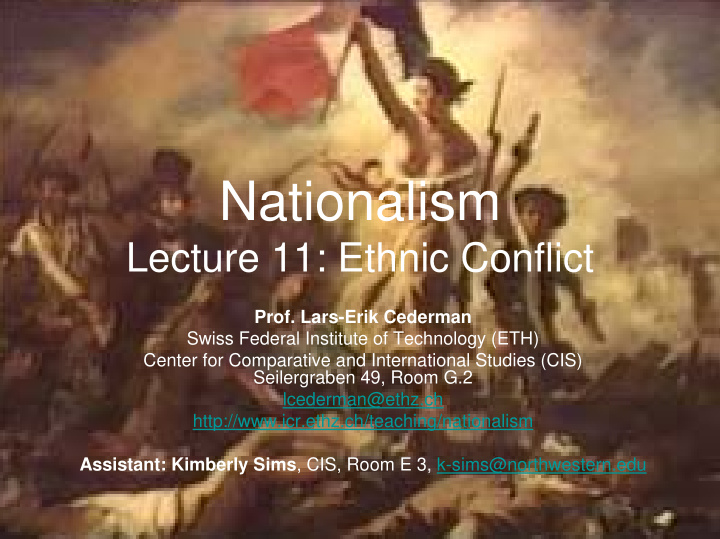



Nationalism Lecture 11: Ethnic Conflict Prof. Lars-Erik Cederman Swiss Federal Institute of Technology (ETH) Center for Comparative and International Studies (CIS) Seilergraben 49, Room G.2 lcederman@ethz.ch http://www.icr.ethz.ch/teaching/nationalism Assistant: Kimberly Sims , CIS, Room E 3, k-sims@northwestern.edu
Ethnic Conflict • Definitions • Competing explanations • Empirical cases • How to stop ethnic conflict?
Definitions • Ethnic conflict = conflict targeting members of ethnic group(s) because of their ethnicity • Ethno-nationalist violence is a subtype of the above: – The struggle is over state control or boundaries and involves at least one nationalist movement – Conflict involves violent acts
Definitions II • Spectrum of inter-ethnic relations – Inter-ethnic trust – Inter-ethnic mistrust (discrimination, assimilation, induced migration) – Sporadic acts of violence – Mass killing – Genocide
Definitions III • Genocide = deliberate attempt to destroy an entire ethnic group • Ethnocide = deliberate attempt to destroy an ethnic identity (e.g. through genocide) • Ethnic cleansing = deliberate attempt to remove from a certain territory an “undesirable” ethnic group through deportation and/or systematic killings
Competing explanations • “Ancient hatred” • “Security dilemma” • Constructivist explanations – Fixed state borders: “Scapegoat hypothesis” – Changing state and national boundaries
“Ancient hatred” • Derived from essentialist theories • Old ethnic communities, old conflicts • Emerges due to state collapse • Culture of aggression (e.g. Balkan “personality”)
“Security dilemma” • Constructivist / rationalist perspective based on Hobbesian principles • Emerging anarchy after state collapse (Posen): collective-choice dilemma due to mistrust • Does not assume ancient hatred, instead situational violence • Ex. Ignatieff, Posen, Fearon
A game-theoretic illustration Ancient Hatred: Security Dilemma: Deadlock Game Prisoner’s Dilemma don’t kill kill don’t kill kill don’t don’t 2,2 3,3 1,4 1,4 kill kill 4,1 3,3 4,1 2,2 kill kill Nash Equilibrium
Graphic illustrations of the 3 perspectives inter-ethnic inter-ethnic Ancient relations Puzzle relations hierarchy anarchy A A trust trust Hatred ? mistrust mistrust hatred hatred B B war war time time indepen- dence inter-ethnic inter-ethnic relations relations Construc- Security hierarchy anarchy A A trust trust tivism Dilemma 1 2 mistrust mistrust A' 3 hatred hatred B B 4 war war time time indepen- indepen- nationalization dence dence campaign
Toward a constructivist explanation • Ethno-nationalist violence modern • Critique of security dilemma account: – actor reification: essentialism – actor unity: group cohesion – actor types: where’s the state? • Need a theory of identity formation, especially how state policies trigger conflict • See Gagnon’s “scapegoat theory”
Mann’s macro-sociological theory of ethnic cleansing • Draws on Gellner’s modernism • Large-scale ethnic cleansing involves modern states and nations for mobilization and infra- structure • Threatened rather than collapsed states • Elites and polarized populations • Nationalizing states in Central and Eastern Europe, and post-colonial states
Weiner’s “Macedonian syndrome” • Focus on boundaries • Actor types – national minority (shared ethnic group) – nationalizing state – external national homeland (also nationalizing) • Irredentist tensions radicalize societies • Conflict spreads across borders
Yugoslavia before ethnic cleansing
Bosnia’s new borders (see white line)
Rwandan case • History: Tutsi kingdom • Germans arrive in 1897 • Belgians take over after WWI and favor the Tutsi • Ethnic riots in 1959 • Independence in 1962 • Rwanda “model LDC” but violence under surface
Rwanda
Toward the genocide • Economic decline and social conflict in 1980s • In 1990, exile Tutsi troops try to invade from Uganda • Peace agreement signed in August 1993 • Preparations for genocide
The Rwandan genocide • In April 1994, Hutu President Habyarimana’s plane is shot down • Hutu extremists exploit the incident • Mass killings of Tutsi leaders start immediately: about 800k dead, 130k survive • Western world passive, except France which helps the government
Policy solutions • Essentialists • Constructivists – Inaction – Democratization – Partition – Intervention – Conflict management – Sanctions – Confidence building – Minority rights – Education
Recommend
More recommend